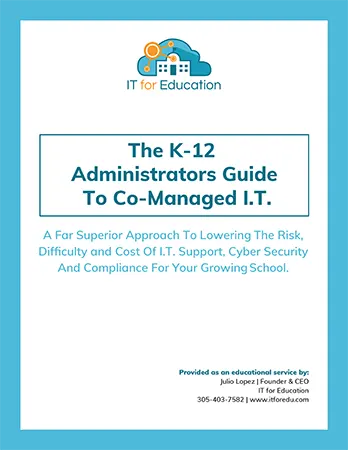
AI is rapidly advancing and transforming how schools teach, manage technology, and connect with their communities. While this innovation is exciting, it also brings new digital risks. Attackers now have access to the same AI tools educators use. Here are a few of the “monsters” lurking in the digital shadows that schools need to be aware of.
Doppelgängers in Your Video Chats – Watch Out for Deepfakes
AI-generated deepfakes have become alarmingly realistic, and cybercriminals are using them in social engineering attacks against schools and districts.
There have been cases where hackers impersonated district leaders or administrators in online meetings, convincing staff members to download “meeting extensions” or access tools that secretly contained malware.
For schools, these scams can disrupt verification processes and create confusion among staff. To identify potential deepfakes, pay attention to signs like facial inconsistencies, awkward silences, robotic movements, or unusual lighting. If something feels off, pause the meeting and verify the participant through another channel before taking any action.
Creepy Crawlies in Your Inbox – Stay Wary of Phishing Emails
Phishing attacks aren’t new, but AI has made them harder to detect. Attackers now use AI to craft convincing emails without the usual warning signs like spelling mistakes or awkward phrasing.
Even more concerning, cybercriminals are using AI to translate and personalize phishing messages for teachers, staff, and administrators, allowing them to scale attacks quickly.
The same cybersecurity principles still apply. Schools can stay protected by requiring multifactor authentication to prevent unauthorized logins, offering cybersecurity awareness training to help staff recognize red flags, and encouraging everyone to verify requests through official channels before responding or clicking on links.
Skeleton AI Tools – Malware in Disguise
Attackers are also taking advantage of the growing popularity of AI by creating fake “AI tools” that trick users into downloading malware. Many of these scams are disguised as helpful “AI classroom tools” or “AI grading assistants.”
These malicious downloads often appear legitimate but contain code that can steal data, passwords, or even access to your school’s network. Some fake AI tools shared on social media have been discovered to distribute malware disguised as “free software for teachers.”
The best defense is simple: never download or test new tools without consulting your IT department or Managed Service Provider. Before introducing an AI platform into your classroom or school workflow, have IT for Education review it to ensure it’s safe, secure, and compliant with your school’s technology policies.
Ready to Chase the AI Ghosts Out of Your School?
AI threats don’t have to keep you up at night. From deepfakes to phishing to fake AI tools, attackers may be getting smarter, but your defenses can be stronger.
IT for Education helps schools stay one step ahead with cybersecurity awareness training, AI safety reviews, and proactive technology planning. Schedule a free discovery call today to learn how we can help protect your faculty, staff, and students from the scary side of AI before it becomes a real problem.
Schedule your free discovery call today and let’s talk through how to protect your team from the scary side of AI ... before it becomes a real problem. https://www.itforedu.com/schedule/



